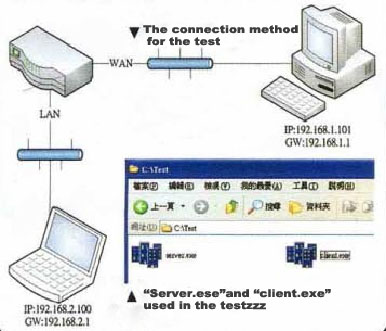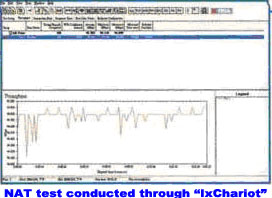- Dec.2006
- 29
TL-WR541G RANK THE FIRST IN THE COMPARISON TEST CONDUCTED BY THE CHINESE HONGKONG MEDIUM "E-ZONE"
The application of WLAN network is becoming more and more popular in recent years, the main reason for which is the frequent decrease in the price of relevant products. For example, the price for wireless router was more than HKD1000 or several thousands when it first entered into the network market, while we can buy a wireless router in the market at about HKD200 or HKD300 now, which makes the bottom prices for WLAN decreased in a large extent.
As we all know, it is far from easy to make the best choice from the routers of different brands which are of the similar prices. The medium DIYzone conducted an overall comparison test for 6 famous wireless routers in the Chinese Hongkong market which are priced lower than HKD300, and offered a moderate, detailed and deep report today for those who tend to buy an ideal wireless router. Except the standard NAT and wireless efficiency test, a simulating test was conducted aiming at comparing the maximum connections when using BT for downloading.
◆ Furious competition
rehensive appraisal from comparison tests for the selected wireless routers, DIYzone executes the appraisal through the following 4 rounds of tests. Scores are given for each round according to each router’s performance, the highest score for each round is 5, the lowest is 1.
-
P2P Simulating test for the upper limit of connections
-
Test for NAT efficiency
-
Test for the performance of Wireless Connection
-
Materials used, functions and price
·Round 01 P2P simulating test for the upper limit of connections
Formerly, the quality of a wireless router was decided by its NAT effieciency. However, there are less disparities in NAT speeds for today’s routers, so whether a router is of high efficiency should be judged through the amount of its NAT Sessions now.
Simply speaking, the larger the upper limit amout for supporting NAT Sessions, the higher the speed shared on P2P softwares such as“Bit Torrent”.
Preparations for the test
In order to test the upper-limit connections of the wireless routers, DIYzone uses two computers to connect the WAN port and LAN port of the routers respectively, then set up the internet connection mode as Static IP, 192.168.2.100 for LAN port, and 192.168.1.101 for WAN port. The test is then conducted through “server.ese” and “client.exe”.
The computer connected to WAN port executes “server 192.168.1.101.12345” to receive connections; while the one connected to LAN port executes “client 192.168.2.100 20000 192.168.1.101 12345”. NAT Session is started from Port 20000, then is connected to Port 12345 of the computer at the WAN side. Spectators are then able to see that the Session number of the Client formality is increasing. When the number ceases to increase, it is the upper limit for the wireless router. Additionally, in order to make the test more accurate, each router is tested for twice and the higher figure is adopted. What’s more, the wireless routers for testing are restarted to clear out their memories.


The websites for downloading the formulas for upper limit of connections:
http://matrix21.myweb.hinet.net/client.exe
http://matrix21.myweb.hhinet.net/server.exe
Analysis: The number of connections is subject to the capacity of router’s memory
The performance of Planex BLW-54CW is the best among the 6 routers tested. Its upper limit for connection numbers could reach up to 1358, which is higher than other router’s 1100 connection upper limit, so its P2P performance is better.
To conclude, one of the main reasons for the disparities in connection upper limit among different routers is the differences in the capacity of memories built in the products, except that different products uses network processing wafers of different brands. The larger the capacity of a memory, the more the connections can be processed, because the memory can also be used to record the NAT Sessions as well as being used as a Packet Buffer. For example, BLW-54CW is built in with a 16MB memory, the NAT Sessions it could record are accordingly more than the other routers.
TIPS: The reasons for influencing the speed of BT
The test for NAT efficiency mainly reflects the performance of routers under Single Connection, while it is not enough by only testing the NAT efficiency, since the transfer, exchange means of files are changing. Taking the most popularized P2P(Point to Point) file-share methods, such as “Bit Torrent”, “eMule” as examples: when downloading files, the softwares should build connections with scores of and even hundreds of users, and the router should process a large number of NAT Sessions. Compared with Single Connection, P2P demands more for the resourses of the built-in network processor, so that the more the NAT Sessions could be processed by the router, the better the router’s performance will be under P2P.

·Round 02 The test for NAT efficiency

This round tests the NAT effiencies of the wireless routers selected under Single Connection. The setup of hardwares is the same as that of Round 01, while the softwares are changed to the network testing software “IxChariot”, and is set up by the built-in “High_Performance_Throughput.scr” to test the performance of NAT uploading, NAT downloading and the in-phase uploading and downloading of the 6 routers being tested.
Model, Download, Upload, In-phase upload and download, Scores
Analysis: Similar NAT performance
The NAT performances of the 6 wireless routers are quite similar to each other’s. No matter at the download from WAN to LAN, or at the upload from LAN to WAN, they all provide an efficiency performance of about 95Mbps, which is close to the Fast Ethernet’s physical limit of 100Mbps which is supposed to be supported by routers.
·Round 03 The test for Wireless Connection
Round 01 and round 02 have mainly tested the connections of cabled network and the NAT efficiency of the wireless routers. In this round, DIYzone will test for the Wireless Connection performance of the wireless routers. Since the 6 routers for testing all support Standard IEEE 802.11G, DIYzone uses the Intel PRO/Wireless 3945 module built in the notebook PC to connect the wireless routers and test their speeds at Point 1 and Point 2.

Remarks:
Point 1: The computer is 1 meter away from the wireless router and there are no obstructs between them.
Point 2: The computer is 6 meters away from the wireless router and there is a wall between them as to simulate the common household environment.
Analasis: The design of antenna will influence the signal coverage
For the test at Point 1, the 6 routers are all able to perform at the highest effieciency of IEEE 802.11G, that is, the speed of about 22Mbps for uploading and downloading, and there are no evident disparities, since the computer is quite close to the routers.
When it comes to the test at Point 2, the disparities in the performance of the 6 routers are enlarged, since the distance is further and there is a wall between, weakening the signals a lot. However, the TP-Link TL-WR541G has made the best performance in this round of test, because of its support for eXtended Range and its adoption of a 5dBi antenna.
·Round 04 Materials used, Functions and Price
After the previous 3 rounds of competition, this round will score for the routers from the aspects of their materials used, their functions and their prices.
Model, Network processing wafer, Memory, Affiliated functions, Price
Analysis: Different materials for close prices
Though very close to each other in price, the lowest at HKD239, and the highest at HKD299, with only a discrepancy of HKD60, there are evident disparities in their materials used and their functions. Among the 6 routers, Planex and TP-Link are the most outstanding two for the adoption of a built-in 16MB memory and a 5dBi antenna respectively.
◆ The schedule for the 4 rounds of test
Model, Total Score
Round 01: P2P simulating test for the upper limit of connections
Round 02: Test for NAT efficiency
Round 03: Test for the performance of Wireless Connection
Round 04: Materials used, Functions and Price
Comment: TP-Link is proven to be the best
To conclude from the 4 rounds of test, the TP-Link TL-WR541G has won at an almost perfect score of 19 for its excellent performance in NAT efficiency, Wireless Connection, as well as the Materials used, Functions and Price. The Planex BLW-54CW ranks the second. Though it has a built-in 16MB memory and has shown the best performance in the P2P simulating test, it is scored 16 and defeated by the TP-Link TL-WR541G for its common wireless performance and comparatively high price.



